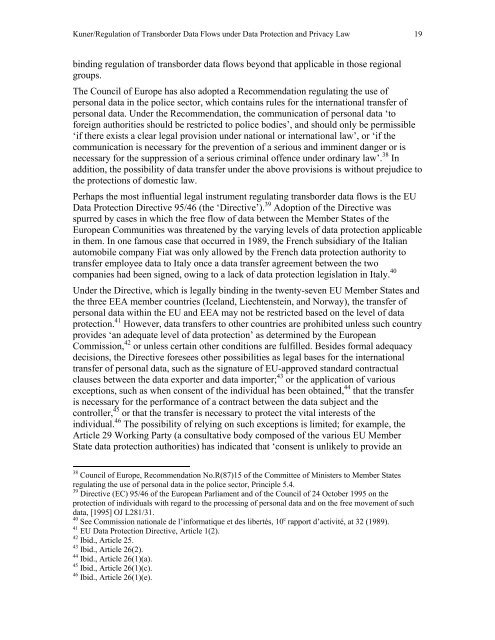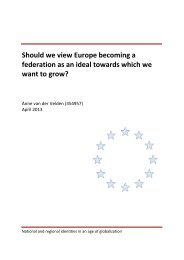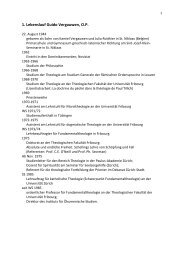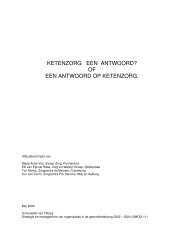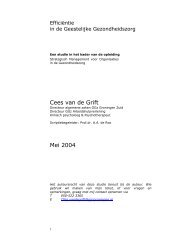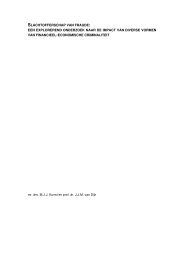Regulation of Transborder Data Flows under ... - Tilburg University
Regulation of Transborder Data Flows under ... - Tilburg University
Regulation of Transborder Data Flows under ... - Tilburg University
You also want an ePaper? Increase the reach of your titles
YUMPU automatically turns print PDFs into web optimized ePapers that Google loves.
Kuner/<strong>Regulation</strong> <strong>of</strong> <strong>Transborder</strong> <strong>Data</strong> <strong>Flows</strong> <strong>under</strong> <strong>Data</strong> Protection and Privacy Law 19<br />
binding regulation <strong>of</strong> transborder data flows beyond that applicable in those regional<br />
groups.<br />
The Council <strong>of</strong> Europe has also adopted a Recommendation regulating the use <strong>of</strong><br />
personal data in the police sector, which contains rules for the international transfer <strong>of</strong><br />
personal data. Under the Recommendation, the communication <strong>of</strong> personal data ‘to<br />
foreign authorities should be restricted to police bodies’, and should only be permissible<br />
‘if there exists a clear legal provision <strong>under</strong> national or international law’, or ‘if the<br />
communication is necessary for the prevention <strong>of</strong> a serious and imminent danger or is<br />
necessary for the suppression <strong>of</strong> a serious criminal <strong>of</strong>fence <strong>under</strong> ordinary law’. 38 In<br />
addition, the possibility <strong>of</strong> data transfer <strong>under</strong> the above provisions is without prejudice to<br />
the protections <strong>of</strong> domestic law.<br />
Perhaps the most influential legal instrument regulating transborder data flows is the EU<br />
<strong>Data</strong> Protection Directive 95/46 (the ‘Directive’). 39 Adoption <strong>of</strong> the Directive was<br />
spurred by cases in which the free flow <strong>of</strong> data between the Member States <strong>of</strong> the<br />
European Communities was threatened by the varying levels <strong>of</strong> data protection applicable<br />
in them. In one famous case that occurred in 1989, the French subsidiary <strong>of</strong> the Italian<br />
automobile company Fiat was only allowed by the French data protection authority to<br />
transfer employee data to Italy once a data transfer agreement between the two<br />
companies had been signed, owing to a lack <strong>of</strong> data protection legislation in Italy. 40<br />
Under the Directive, which is legally binding in the twenty-seven EU Member States and<br />
the three EEA member countries (Iceland, Liechtenstein, and Norway), the transfer <strong>of</strong><br />
personal data within the EU and EEA may not be restricted based on the level <strong>of</strong> data<br />
protection. 41 However, data transfers to other countries are prohibited unless such country<br />
provides ‘an adequate level <strong>of</strong> data protection’ as determined by the European<br />
Commission, 42 or unless certain other conditions are fulfilled. Besides formal adequacy<br />
decisions, the Directive foresees other possibilities as legal bases for the international<br />
transfer <strong>of</strong> personal data, such as the signature <strong>of</strong> EU-approved standard contractual<br />
clauses between the data exporter and data importer; 43 or the application <strong>of</strong> various<br />
exceptions, such as when consent <strong>of</strong> the individual has been obtained, 44 that the transfer<br />
is necessary for the performance <strong>of</strong> a contract between the data subject and the<br />
controller, 45 or that the transfer is necessary to protect the vital interests <strong>of</strong> the<br />
individual. 46 The possibility <strong>of</strong> relying on such exceptions is limited; for example, the<br />
Article 29 Working Party (a consultative body composed <strong>of</strong> the various EU Member<br />
State data protection authorities) has indicated that ‘consent is unlikely to provide an<br />
38<br />
Council <strong>of</strong> Europe, Recommendation No.R(87)15 <strong>of</strong> the Committee <strong>of</strong> Ministers to Member States<br />
regulating the use <strong>of</strong> personal data in the police sector, Principle 5.4.<br />
39<br />
Directive (EC) 95/46 <strong>of</strong> the European Parliament and <strong>of</strong> the Council <strong>of</strong> 24 October 1995 on the<br />
protection <strong>of</strong> individuals with regard to the processing <strong>of</strong> personal data and on the free movement <strong>of</strong> such<br />
data, [1995] OJ L281/31.<br />
40 e<br />
See Commission nationale de l’informatique et des libertés, 10 rapport d’activité, at 32 (1989).<br />
41<br />
EU <strong>Data</strong> Protection Directive, Article 1(2).<br />
42<br />
Ibid., Article 25.<br />
43<br />
Ibid., Article 26(2).<br />
44<br />
Ibid., Article 26(1)(a).<br />
45<br />
Ibid., Article 26(1)(c).<br />
46<br />
Ibid., Article 26(1)(e).


